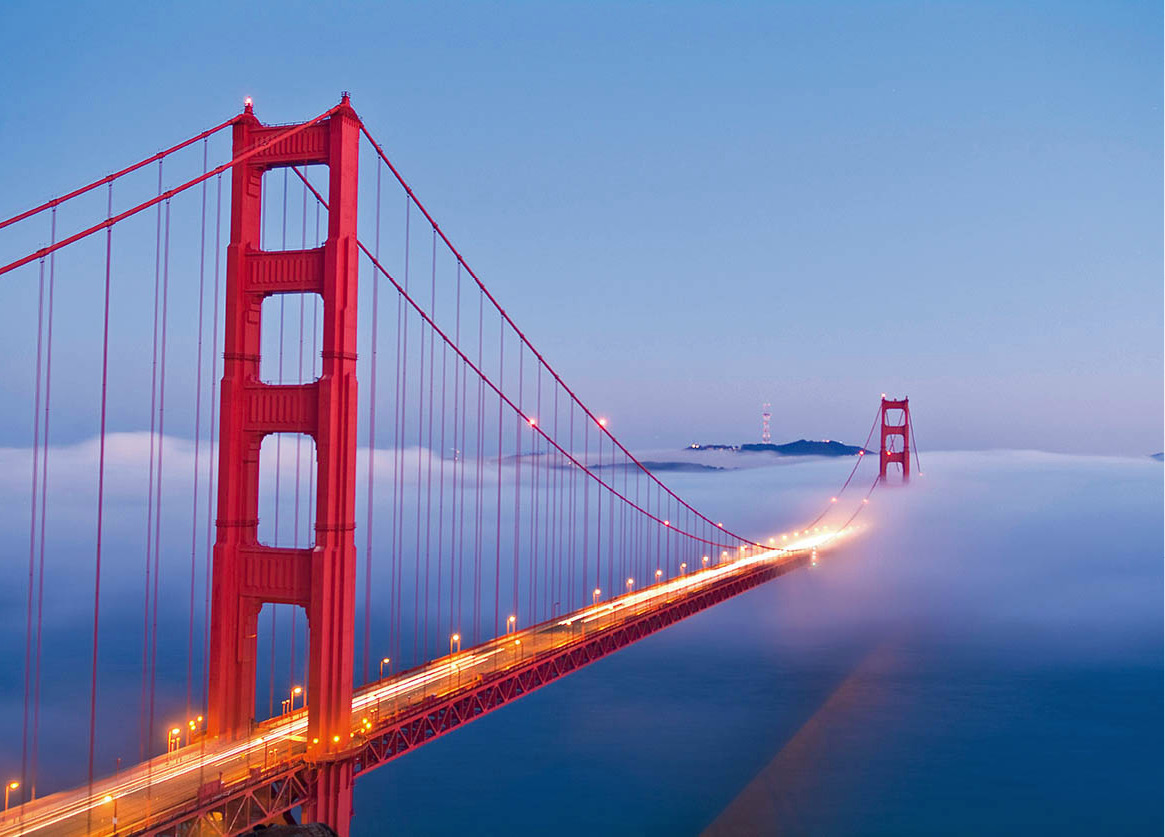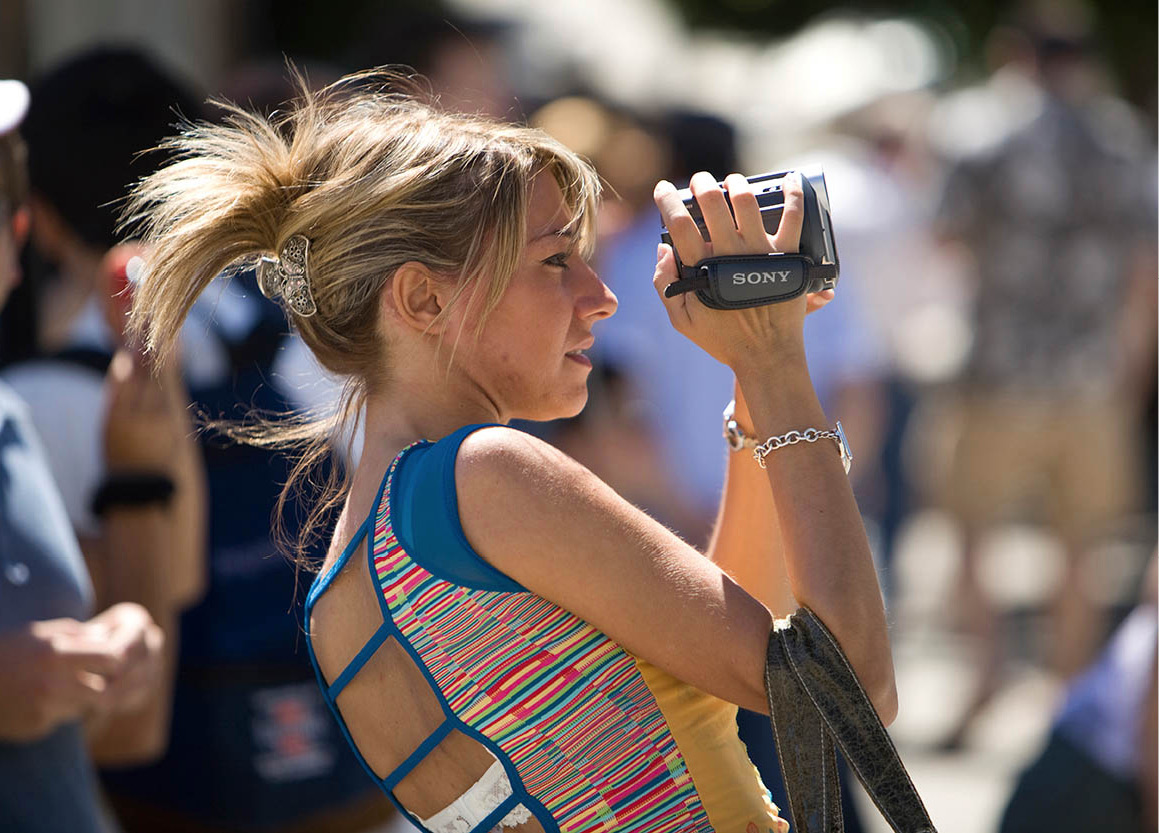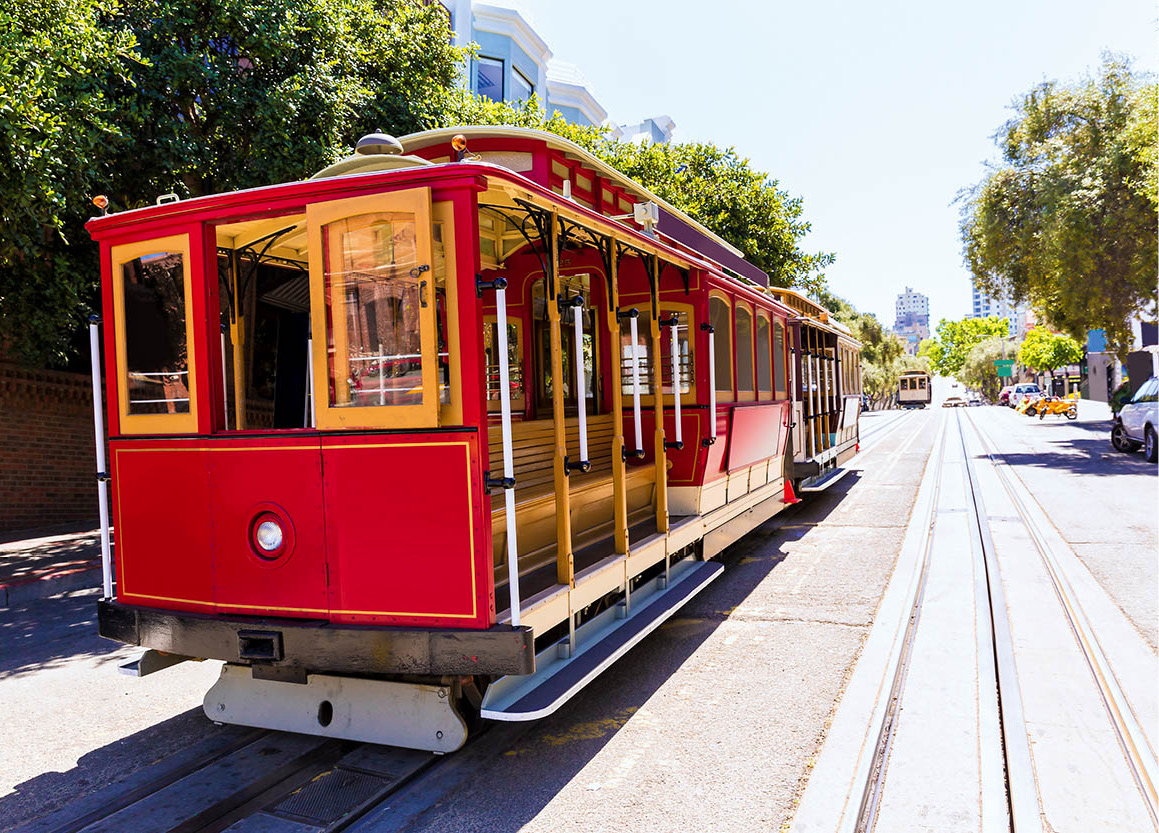With dramatic views from impossibly steep hills, inventive cuisine that caters to foodies, diverse cultural attractions, and vibrant neighborhoods, San Francisco is an easy city to love. Often considered the most European of large American cities, the lively, compact metropolis spans some 49 square miles (127 sq km), broken up by 43 windswept and fog-capped hills. These scattered slopes define the city’s skyline and urban landscape, offering arresting views of elegant bridges and the glistening blue-green Pacific and San Francisco Bay.

Golden Gate Bridge
Nowitz Photography/Apa Publications
Hidden gems
Tucked on and around the hills of San Francisco are dozens of small, distinct neighborhoods with their own microclimates, stereotypes, and special attractions. Landmarks like Alcatraz, the Golden Gate Bridge, Chinatown, and the city’s cable-cars, as well as the endless array of lesser known attractions − mural-lined alleys, a literary festival, and a 1910 hardware store that sells just about everything! − all contribute to the special charm of the City by the Bay.
city development
San Francisco is no stranger to the spotlight on the world’s stage. Throughout the city’s history, more than one boom and bust has drawn international attention. In the 19th century, the discovery of gold in the Sierra foothills ignited the largest mass migration in history, with treasure-seekers flooding the then small town of 2,000 and turning it into a proper city of 10 times that size. In 1906, the world’s attention was drawn to San Francisco when it was struck by a massive earthquake measuring an estimated 8.3 on the Richter scale. Coupled with the ensuing fire that raged for three days, the earthquake left the city in ruins. Then, later in the 20th century, the San Francisco Bay Area witnessed first-hand the prosperous dot-com era and its subsequent rapid unraveling.
Center stage
The city has also attracted attention for its significant role in political moments and countercultural movements. The stage of the War Memorial Opera House saw the signing of the United Nations permanent charter in 1945. Then, in the late 1950s, North Beach became Beat-central, attracting writers such as Jack Kerouac, Allen Ginsberg, Lawrence Ferlinghetti, Philip Whalen, and Michael McClure.
In 1967, thousands of hippies descended on Haight-Ashbury and Golden Gate Park during the “Summer of Love.” More recently, the city has become a focal point for the gay community’s battles for equal rights; when Mayor Gavin Newsome began signing same-sex marriage licenses in 2004, the gay marriage issue became a national talking point.
Contemporary appeal
Yet, no matter what dramas befall this city, its charms only seem to grow. Millions of visitors come each year to absorb San Francisco’s legacy, explore Alcatraz, admire stunning views, dine on first-class cuisine, shop to their hearts’ content, and climb impossibly steep hills in the city’s iconic cable-cars. Whichever aspect of San Francisco intrigues, most visitors find it is difficult not to leave one’s heart here.
Geography
At just 7 sq miles (18 sq km) and with a population of around 800,000, San Francisco is small for a major city in terms of both geography and population. Yet, for a city of such narrow limits, San Francisco covers a huge spectrum of natural and social terrain. The city sits on a bay over 400 sq miles (1,000 sq km) in area, which is crossed by five bridges. One of these bridges is the world-famous Golden Gate Bridge, which was completed in 1937 and still remains an enduring, defining symbol of San Francisco. Space in the compact city is at a premium today, with real-estate prices among the highest in the country.
Don’t Call It Frisco
The surest way of giving yourself away as a tourist in San Francisco is to call the city “Frisco.” Newspaperman Herb Caen, chronicler of things San Franciscan, felt strongly enough to name his book Don’t Call It Frisco. Unpopular with locals since the 1930s, the name is not a corruption of Francisco, but is thought to be from an old English word, frithsoken, meaning refuge, and was used by sailors to refer to a port with repair yards. Another nickname to avoid? San Fran. Instead, blend in with the locals by calling it “SF” or simply, “The City.”

Capturing the San Francisco scene
Nowitz Photography/Apa Publications
Diverse neighborhoods
There is a very strong sense of neighborhood in San Francisco, with locals taking immense pride in their home and promoting a stronger sense of community than is found in many other cities of similar stature. There are over a dozen neighborhood enclaves, each with a distinct culture and identity, including the bustling Chinatown, multicultural North Beach, gritty Tenderloin, Latino- and hipster-dominated Mission, gay-friendly Castro, alternative Haight-Ashbury, upper-crust Pacific Heights, tony Russian Hill, old-fashioned Nob Hill, and preppy, post-collegiate Marina and Cow Hollow.
San Francisco’s outlying districts are equally distinctive. For instance, the vast, residential Sunset and Richmond districts are home to many Russian, Irish, and Chinese families, and offer commercial hubs filled with bookstores, grocery stores, and Asian restaurants. The Richmond is also bisected by Lincoln Park, home to the Palace of the Legion of Honor, wild coastline trails, and lucky views of the Golden Gate Bridge.

San Francisco skyline
Dreamstime
Climate
The city’s climate is generally agreeable, but can vary from hour to hour and even between neighborhoods. Spring is warm and sunny, while summer is cooler and overcast, with the city often blanketed in fog. Come the fall, the city’s real summer swings into effect, with mild and sunny days. The majority of the rainfall occurs in December and January, though crisp, sunny days offer respite from those that are damp and cloudy.
Contrary to the common misconception of a lush California, much of the state is, in fact, a semi-desert. Its Mediterranean climate, where 98 percent of its annual rainfall occurs between November and March, leaves it vulnerable to drought and wildfires the rest of the year. Still, these natural hazards, along with the possibility of earthquakes and the reality of frequent fog, do little to quell the city’s popularity.
Earthquakes
From its plunging cliffs to its dramatic peaks and valley, the astounding natural beauty of the Bay Area is the result of shifting tectonic plates. Sitting between two major seismic fault lines – the San Andreas skirting the edge of the city and the Hayward running up the East Bay – San Francisco is continually under threat of jolts that can cause millions of dollars’ worth of damage. Fortunately, improved building codes and “retrofitting” (structural revamping) have stabilized all the bridges, highway overpasses, and downtown buildings that suffered in previous quakes.
Despite the threat, San Franciscans handle the subject of earthquakes with great aplomb, shrugging their shoulders with a “What can you do?” attitude. Still, every California school kid learns the basic rules: if an earthquake occurs, stay indoors, preferably under something sturdy like a piece of furniture or in a doorframe; if outside, avoid trees, power lines, buildings, and bridges.

The Beat Museum documents the city in the mid-20th century
Nowitz Photography/Apa Publications
THE PEOPLE
San Francisco is truly a multicultural city, with diverse demographics representing all ethnicities and proclivities. The Chinatown area is famous, but San Francisco also has a vibrant Hispanic-origin population and large communities of people of Italian, Japanese, Russian, and Southeast Asian descent. Indeed, only 35 percent of San Franciscans were born in California, while 39 percent were born outside of the U.S. San Francisco is known internationally for its large gay and lesbian population, which crosses all ethnic divisions and wields significant political power in the city. Many are attracted to San Francisco by its liberal, accommodating spirit. Tolerance is part of the city’s ethos, not to mention public policy: tolerance of cultural, religious, racial, and gender divergences are hard-wired into the city’s civic codes and legislation.

SF resident
Nowitz Photography/Apa Publications
Living standards
The general standard of living is high, and the average earnings of residents enable enough eating out and nights on the town to sustain the city’s dining and cultural establishments. However, San Francisco also has a large and visible homeless population. Initiatives are making a difference, but visitors will undoubtedly notice the many down-and-outs.

Eye-catching auto repair shop sign
Nowitz Photography/Apa Publications
Don’t leave San Francisco without…
Sampling the Ferry Building farmers market. There’s no better way to spend a Saturday morning than tasting your way through the fresh fruit, local cheese, salumi, flavored olive oils, and other artisanal offerings here. For more information, click here.
Book-browsing at the City Lights Bookstore. Pay homage to the city’s literary tradition at this Beat landmark owned by Lawrence Ferlinghetti. For more information, click here.
Riding a cable car. As the 1910 landmarks rumble and ding over Nob Hill at a deliberate 9.5 mph, it’s impossible not to enjoy yourself. Take the scenic Powell-Hyde route for a peek down crooked Lombard Street. For more information, click here.
Exploring a Secret Garden-esque staircase. With serene atmosphere and gorgeous views, the garden-lined staircases of Telegraph Hill and Russian Hill are some of the prettiest and most quietly intriguing blocks in the city. For more information, click here or click here.
A night at the museum. Every Thursday evening, the California Academy of Sciences transforms into a popular (and kid-free) social event; the Exploratorium does the same every first Thursday of the month. For more information, click here.
Ordering an Irish coffee at the Buena Vista. After all, it was invented here! For more information, click here.
Experiencing the Mission like a local. Hit up one of the sunny district’s famed taquerías, then relax at Dolores Park − easily the city’s biggest park scene in the city on weekends − or burn off your burrito walking past bold murals and offbeat shops. For more information, click here.
Playing old-fashioned penny arcade games. Musée Mécanique is a must-see in Fisherman’s Wharf. Bring a pocket-full of quarters! For more information, click here.
Walking through the heart of Chinatown. Stroll bustling, lantern-lined Grant Street and picturesque Waverly Place, and nibble fresh fortune cookies in Ross Alley. For more information, click here.
Soaking up views of the bridges − yes, both of them. Walk or bike the famous Golden Gate Bridge, or admire it while sipping a martini at the Top of the Mark. The Bay Bridge − with its eye-catching LED lightshow − is just as impressive at night. For more information, click here.
Health and Environment
San Francisco has rightly developed a reputation for being very eco-friendly, with a broad recycling program (even composting is required), a significant bike-riding population, some of the world’s toughest anti-pollution laws, and countless campaigns to “green” the city by planting trees and native species on rooftops and in public places. Nevertheless, it is also a densely populated metropolitan area that carries inevitable environmental concerns, ranging from air quality to water shortages.
San Franciscans are also notoriously concerned with the health of their bodies and souls. There is an abundance of gyms and yoga studios, natural food stores and fresh farmers markets, spas and alternative health practitioners, and vegetarian and even vegan restaurants.
Recreation
Having a good time is an easy order to obey in the city that lays claim to the first espresso on the West Coast and to being the home of the Martini. The rich nightlife, food, and cultural pickings ensure that foodies, film buffs, bar-hoppers, jazz fiends, aspiring poets, and 1960s nostalgists all have plenty to enjoy.
The city is home to numerous museums, with the majority clustered downtown and in the South of Market district, although a number are strewn about outlying neighborhoods. The heavy-hitters include the San Francisco Museum of Modern Art (SFMOMA), the Legion of Honor, the de Young, and the Asian Art Museum. Several other museums celebrate San Francisco’s history and its ethnically diverse population.
Fresh-air enthusiasts are also spoiled for choice in San Francisco, with nearly every kind of outdoor activity on offer, from sailing and windsurfing on the bay to biking, baseball, basketball, tennis, polo, and fly-fishing in the sprawling Golden Gate Park, the urban oasis that stretches 52 city blocks from the Haight-Ashbury neighborhood to the ocean.

Powell−Hyde line cable car
Bigstock

Musée Mécanique
Nowitz Photography/Apa Publications

Picnic in Dolores Park
Nowitz Photography/Apa Publications
Top Tips
Advance booking. Since San Francisco is a very popular convention and tourist town, it’s important to make reservations well ahead of time, both for hotels, Alcatraz tours, and any popular restaurants on your must-eat list. An advantage of booking hotels by phone is that you can request a view, which can make or break a hotel room in San Francisco.
Getting around. For frequent travel on buses, it’s worth buying a pass; these can be bought to cover one, three, or seven days, or a month. Visit www.sfmta.com for details. To find out when your bus is actually coming (as opposed to the scheduled time) visit www.nextmuni.com for real-time data.
Parking. Parking in San Francisco can be difficult to find and expensive. See www.sfmta.com/getting-around/parking for information on open lots and spaces, what curb and meter colors mean, street sweeping and holiday exceptions, and other general rules.
Open for business. Most shops are open every day, but with shorter hours on Sunday (typical hours are Mon–Sat 10am–7pm and Sun noon−6pm). Many restaurants are closed on Mondays.
Restaurant reservations. Need a dinner reservation for tonight? You can skip the hassle of calling multiple individual restaurants to check availability by using Open Table (www.opentable.com). The popular website allows you to search by multiple criteria − including time, neighborhood, cuisine, party size, and price − then book your reservation online. For all the latest San Francisco restaurant news, check http://sf.eater.com.
Tipping. Tipping in the U.S. is not optional: 15−18 percent is standard, and 20 percent means you were happy with both service and food. Percentages are calculated pre-tax. A quick way of calculating is to double the tax (8.5 percent) and round up or down depending on level of satisfaction.
Dress codes. Going out in San Francisco isn’t necessarily a fancy affair and few restaurants or bars have dress codes. Only the nightclubs and top-notch restaurants truly merit dress-up attire, though in some mid-range restaurants you may feel more comfortable in something a step up from T-shirt and sneakers.
Tickets. Discount tickets can be bought for shows and other events from the TIX kiosk at Union Square.
Getting in. Most bars and clubs are 21 and over, with I.D. required at the door. At dive bars, cash-only policies are common, but the bartender can usually point you to the nearest ATM (which is sometimes in the bar itself). Entrance fees are also usually cash only.
First Tuesdays and Thursdays. On the first Tuesday of the month, many museums offer free admission. On the first Thursday of each month, the San Francisco tradition of “First Thursdays” turns typically calm galleries into lively, wine-sipping social events. Many galleries schedule their show openings and then keep their doors open later than usual.